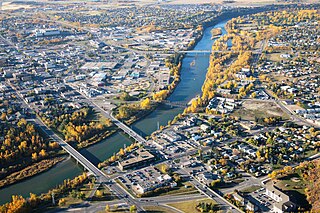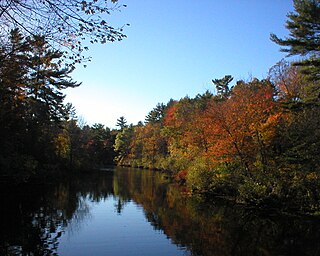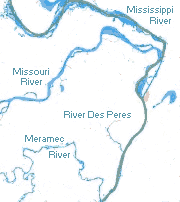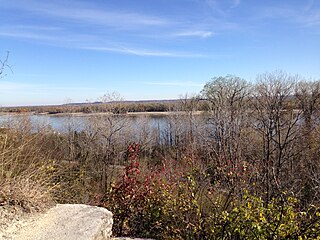
Bloomington is a city in and the county seat of McLean County, Illinois, United States. The 2020 census showed the city had a population of 78,680, making it the 13th-most populous city in Illinois and the fifth-most populous outside the Chicago metropolitan area. It is adjacent to the town of Normal, and is the more populous of the two principal municipalities of the Bloomington–Normal metropolitan area, which has a population of roughly 170,000. Bloomington is 135 miles (217 km) southwest of Chicago and 162 miles (261 km) northeast of St. Louis. Bloomington is home to Illinois Wesleyan University and the headquarters for State Farm and Country Financial.

Red Deer is a city in Alberta, Canada, located midway on the Calgary–Edmonton Corridor. Red Deer serves central Alberta, and its key industries include health care, retail trade, construction, oil and gas, hospitality, manufacturing and education. It is surrounded by Red Deer County and borders on Lacombe County. The city is in aspen parkland, a region of rolling hills, alongside the Red Deer River.
The Saint Louis Zoo, officially known as the Saint Louis Zoological Park, is a zoo in Forest Park, St. Louis, Missouri. It is recognized as a leading zoo in animal management, research, conservation, and education. The zoo is accredited by the Association of Zoos and Aquariums (AZA). Admission is free based on a public subsidy from a cultural tax district, the Metropolitan Zoological Park and Museum District (ZMD); fees are charged for some special attractions. A special feature is the 2 ft narrow-gauge Emerson Zooline Railroad with passenger trains pulled by Chance Rides C.P. Huntington locomotives that encircle the zoo, stopping at the more popular attractions.

Sherwood Park is a large hamlet in Alberta, Canada within Strathcona County that is recognized as an urban service area. It is located on traditional Treaty 6 territory, and adjacent to the City of Edmonton's eastern boundary. While long confined to generally south of Highway 16, west of Highway 21 and north of Highway 630, portions of Sherwood Park have expanded beyond Yellowhead Trail and Wye Road since the start of the 21st century. Anthony Henday Drive (Highway 216) separates Refinery Row, in a portion of the Sherwood Park Urban Service Area to the west, from the residential and commercial hamlet to the east.

Forest Park is a public park in western St. Louis, Missouri. It is a prominent civic center and covers 1,326 acres (5.37 km2). Opened in 1876, more than a decade after its proposal, the park has hosted several significant events, including the Louisiana Purchase Exposition of 1904 and the 1904 Summer Olympics. Bounded by Washington University in St. Louis, Skinker Boulevard, Lindell Boulevard, Kingshighway Boulevard, and Oakland Avenue, it is known as the "Heart of St. Louis" and features a variety of attractions, including the St. Louis Zoo, the St. Louis Art Museum, the Missouri History Museum, and the St. Louis Science Center.

Richard Warren Joseph Hayman was an American musician who was the chief music arranger of the Boston Pops Orchestra for over 50 years, and served as a pops conductor for orchestras including the Detroit Symphony Orchestra, the St. Louis Symphony and the Grand Rapids Symphony in Grand Rapids, Michigan.

Runyon Canyon Park is a 160-acre (65 ha) park in Los Angeles, California, at the eastern end of the Santa Monica Mountains, managed by the Los Angeles Department of Recreation and Parks. The southern entrance to the park is located at the north end of Fuller Avenue in Hollywood. The northern entrance is off the 7300 block of Mulholland Drive. The Runyon Canyon Road, a fire road that is closed to public motor vehicle access, runs roughly through the center of the park between the northern and southern entrances along Runyon Canyon itself, and there are numerous smaller hiking trails throughout the park. The highest point in the park at an elevation of 1,320 ft is known as Indian Rock. Because of its proximity to residential areas of Hollywood and the Hollywood Hills, celebrity sightings are common. The park is also noted for having a fairly liberal dog policy, with dogs allowed off-leash in 90 of the park's 160 acres (0.65 km2). The park is part of the Santa Monica Mountains National Recreation Area.

Cimarron National Grassland is a National Grassland located in Morton County, Kansas, United States, with a very small part extending eastward into Stevens County. Cimarron National Grassland is located near Comanche National Grassland which is across the border in Colorado. The grassland is administered by the Forest Service together with the Pike and San Isabel National Forests and the Comanche National Grassland, from common headquarters located in Pueblo, Colorado. There are local ranger district offices in Elkhart, Kansas. The grassland is the largest area of public land in the state of Kansas.

Three Rivers Park District is a special park district serving the suburban areas of the Twin Cities including suburban Hennepin, Carver, Dakota, Scott, and Ramsey counties. Three Rivers's mission is "To promote environmental stewardship through recreation and education in a natural resources-based park system." Three Rivers operates twenty parks and ten regional trails, with at least two more regional trails planned. Nearly seven million people visit Three Rivers facilities each year. It has over 27,000 acres (11,000 ha) of parks and trails.

The Forks is a historic site, meeting place, and green space in downtown Winnipeg located at the confluence of the Red River and the Assiniboine River.

Bradley Palmer State Park is a public recreation area covering 736 acres (298 ha) on the Ipswich River in the towns of Hamilton and Topsfield, Massachusetts. The state park was once the estate of noted attorney Bradley Palmer. In addition to an extensive system of multi-use trails, the park features Palmer's restored Willowdale Mansion. The mansion is now home to Willowdale Estate, a premier event venue. Bordered on the north by the Ipswich River and Willowdale State Forest, the park is managed by the Department of Conservation and Recreation.

Laumeier Sculpture Park is a 105-acre open-air museum and sculpture park located in Sunset Hills, Missouri, near St. Louis and is maintained in partnership with St. Louis County Parks and Recreation Department. It houses over 60 outdoor sculptures and features a 1.4-mile (2.3 km) walking trail, and educational programs. There is also an indoor gallery, an 1816 Tudor stone mansion, which was the former residence of Henry and Matilda Laumeier. Laumeier is accredited by the American Alliance of Museums. The park sees about 300,000 visitors each year and operates on a $1.5 million budget.

Red Hills State Park is an Illinois state park on 967 acres (391 ha) in Lawrence County, Illinois, United States. The park sits at an elevation of 515 feet (157 m). Red Hills State Park is open for year-round recreation including boating, fishing, hunting, hiking and various winter sports. The park includes a restaurant which is open year-round and has banquet facilities.
Ramsey Lake State Recreation Area is a 1,980-acre (800 ha) state park located in Fayette County, Illinois, United States. The nearest town is Ramsey, Illinois, and the park is adjacent to U.S. Highway 51. The park is managed by the Illinois Department of Natural Resources (IDNR).

The Great Rivers Greenway District is a public agency created in 2000 to develop a regional network of greenways. Great Rivers Greenway engages citizens and community partners to plan, build and care for the greenways. In its first 20 years the agency built more than 128 miles of greenways connecting parks, rivers, schools, neighborhoods, business districts and transit.
Parks in Greater St. Louis are administered by a variety of state, county, and municipal authorities. The region also is home to Gateway Arch National Park, site of the Gateway Arch, the only National Memorial in the state of Missouri. Among the largest municipal parks is Forest Park, which is 1,293 acres (5.2 km2) and is located in the city of St. Louis, although both Greensfelder County Park and Creve Coeur Park in St. Louis County are larger, at 1,646 and 2,114 acres respectively. St. Louis County is also the location of two large state parks, Babler State Park with 3.8 square miles (9.8 km2) and Castlewood State Park with 2.8 square miles (7.3 km2). The largest state park in the region is Meramec State Park, located near Sullivan, Missouri, with 10.8 square miles (28 km2) of parkland.
Edgar Monsanto Queeny was an American businessman who served as chairman of the Monsanto corporation from 1928 until his retirement in 1960.

Rockwoods Range Conservation Area consists of 1,388 acres (5.62 km2) in western St. Louis County, Missouri. It is just north of Interstate 44 west of Eureka. The land is part of the Henry Shaw Ozark Corridor.

There are a wide range of recreational areas and facilities in Colorado Springs, Colorado.

Cliff Cave Park is a 525-acre public park located in St. Louis County, Missouri. The park is owned and operated by the St. Louis County Department of Parks and Recreation. It is named after Cliff Cave, a natural cave located in the park that is a historical and archaeologic site. The park contains woodlands, wetlands, and rocky hillsides and is adjacent to the Mississippi River. It has three trails: the Mississippi Trail, the Spring Valley Trail, and the River Bluff Trail. The Riverside Shelter overlooks the Mississippi River. An active train track runs through the park. Cliff Cave Park is part of the Mississippi River Greenway. The park won the "Best View of the Mississippi" award in 2009, which it was granted by The Riverfront Times.

















